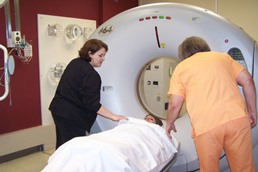
Female Patient is having an MRI scan
Imaging Services
Radiology is a medical specialty that employs the use of imaging to both diagnose and treat disease visualized within the human body.
Here at Bradley County Medical Center, the radiology department uses the latest scientific technology in order to give our patients exceptional care. Our facility offers MRI/MRA, CT, X-ray, Ultrasound, Genius™ 3D Mammography™ exams, Nuclear Medicine and Bone Density.
The Bradley County Medical Center Radiology Department is excited to offer Genius™ 3D Mammography™ exams, developed by Hologic, Inc., a worldwide leader in Women's Health.
BCMC has a new state-of-the-art MRI unit which offers patients local service and prevents patients from having to travel out of town for a MRI. All of these areas of radiology work together to diagnose, treat and evaluate a variety of injuries and conditions for our patients.

MRI vs. CT
CT Scan does not show you tendons and ligaments very well at all; at least not yet. MRI is the best choice for that. Tendons and ligaments around the shoulder and knee are best seen by the physics used in MRI. This is due to the density of the tissues that compose the tendons and ligaments.
Spinal cord is best seen by MRI for the same reason. The density of the spinal cord and the composition of it is such that MRI physics can show it to us much better than CT.
There are also reasons why CT is the exam of choice over MRI. It is the preferred modality for cancer, pneumonia, and abnormal chest x-rays. Bleeding in the brain, especially from injury, is better seen on CT than MRI. But a tumor in the brain is better seen on MRI. CT displays the inner auditory canals and is superior at visualization of the mastoid air cells.
If you've been in an accident, organs can get torn or damaged. CT shows organ tear and organ injury quickly and efficiently. Broken bones and vertebral bodies of the spine are better seen on CT but injury to the spinal cord itself is displayed on MRI far better than CT.
CT is far superior at visualizing the lungs and organs in the chest cavity between the lungs. MRI is not a good tool for visualizing the chest or lungs at all.
CT Scan Upgrade
Computed Tomography (CT) scanning uses special x-ray equipment to generate multiple views of the inside of the body. These multiple x-ray views are reconstructed into cross-sectional images of the body using computer systems. Radiologists use CT scan imagery to more easily diagnose medical problems such as some cancers, cardiovascular disease, trauma, and musculoskeletal disorders.
Bradley County Medical Center has recently upgraded our CT equipment which allows for better resolution and faster reconstruction times. In fact, our new CT reconstructs the exam into images as we do the scan, instead of after exam completion (some machines take up to 1 hour following the exam to reconstruct).
What does that mean for you? Higher image resolution provides more visual diagnostic details to the radiologist. Faster reconstruction time means that the doctor can make decisions for your diagnosis and treatment much faster.
Diagnostic sonography (ultrasonography) is an ultrasound-based diagnostic imaging technique used for visualizing subcutaneous body structures including tendons, muscles, joints, vessels and internal organs for possible pathology or lesions. The practice of examining pregnant women using ultrasound is called obstetric sonography, and is widely used.
Mammography is the process of using low-energy X-rays (usually around 30 kVp) to examine the human breast and is used as a diagnostic and a screening tool. The goal of mammography is the early detection of breast cancer, typically through detection of characteristic masses and/or microcalcifications.
BCMC now offers Genius™ 3D Mammography™ exams. In conventional 2D Mammography, overlapping tissue is a leading reason why small breast cancers may be missed and normal tissue may appear abnormal, leading to unnecessary callbacks. A Genius exam includes a three-dimensional method of imaging that can greatly reduce the tissue overlap effect.
A Genius exam includes both 2D images and tomosynthesis scans. During the tomosynthesis-dimensional portion of the exam, an X-ray arm sweeps in a slight arc over the breast, taking multiple images. A computer then converts the images into a stack of thin layers, allowing the radiologist to review the breast tissue one layer at a time. A Genius exam requires no additional compression and takes just a few seconds longer than a conventional 2D breast cancer screening exam.
Our Genius™ 3D Mammography™ exam, available on the 3Dimensions™ and Selenia® Dimensions® systems from Hologic, are revolutionizing how breast cancer is detected by providing a better option for women of all breast densities compared to 2D alone. Researchers have found that:
• The Genius™ 3D Mammography™ exam finds 20-65% more invasive breast cancers compared to 2D alone, an average increase of 41%.
• Only the Genius™ 3D Mammography™ exam is FDA approved as superior for women with dense breasts compared to 2D alone.
• The Genius™ 3D Mammography™ exam reduces callbacks by up to 40% compared to 2D alone.
BCMC is committed to the fight against breast cancer. In offering the Genius exam, BCMC Radiology provides a more accurate tool for breast cancer screening.
Nuclear medicine is a medical specialty involving the application of radioactive substances in the diagnosis and treatment of disease.
Bone density (or bone mineral density) is a medical term normally referring to the amount of mineral matter per square centimeter of bones.[1] Bone density (or BMD) is used in clinical medicine as an indirect indicator of osteoporosis and fracture risk.
For questions or concerns, please write the Director of Radiology, Deedre Pierce at 870-226-4165.




